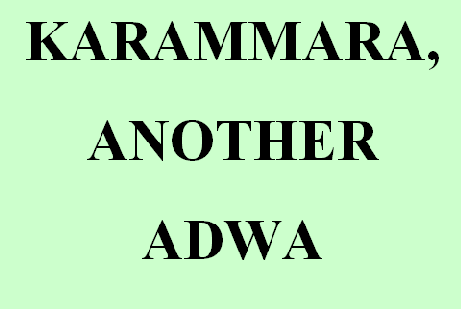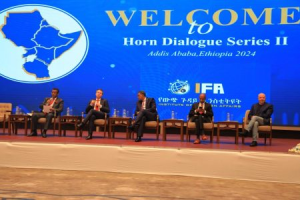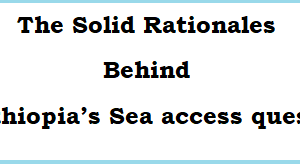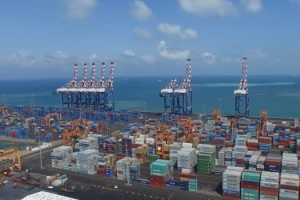
It was on March 6, 1978 that Ethiopian forces inflicted a huge defeat on the arrogant Somali invading forces that came in to Ethiopian sovereign territory led by their president Siad Barre. Ethiopia was then in a state of dynamic change with various forces struggling against the ruling Derg government. Opposition forces were trying to destabilize the country and depose the military government by force. There were rebels in the north of the country with Eritrean guerrilla forces trying to drive away Ethiopian forces from the control of the regional state. At the same time there were Tigray rebels who in collaboration with their comrades in arms were creating a lot of tension in the northern region. Moreover, the Ethiopian Peoples Revolutionary Party, EPRP, was the other front active with the dissident student movement, recruiting in its ranks as many students and youths as possible both from the university campuses as well as from high schools. There was a lot of propaganda going on in the country on the part of EPRP manifestos distributed in leaflets inciting against the military government accusing it of being oppressive and fascist with an authoritarian stance on any number of social issues the opposition were raising. The students were convinced that their struggle was hijacked by the military and wanted to depose it using what ever means was available to them. In fact it was a well organized body in secret cells everywhere having recruited able students where discussion groups were formed secretly and meetings were held to articulate their opposition and ideological underpinnings against the military machinery while the government was engaged in multiple fronts and hence overstretched. There were also other nationalistic ethnic based movements trying to assert their interests against the military establishment.
That was why the Somali forces tried to take the opportunity to invade Ethiopian territory and capture as much as they could alleging that every inch of land in which there were native Somalis and their camels was Somali sovereign land. The design of the Greater Somalia Republic was the dream of the Somali president Mohammed Siad Barre and they had it sealed on their flag with a star of five angles depicting the five parts of the Greater Somalia that included territories from Ethiopia in the Ogaden, Kenya called the Northern Frontier District and Djibouti as well as the northern part of Somalia referred to as Somaliland and the southern part where the capital Mogadishu is situated. It was a sort of pan Somali movement to form a state with all ethnic Somalis under one big state.
Somalia then was under the influence of the USSR, Union of Soviet Socialist Republic, and according to their bilateral agreements the ‘socialist’ government of Mogadishu was in the so called camp of the USSR and the Eastern European socialist group. President Mohammed Siad Barre was heard openly professing ‘scientific socialism’ as the ideological base of his government and this enabled him to have massive military assistance and training by the USSR. It was armed to the teeth and when it observed that the Ethiopian military government was very much busy and engaged in multiple fronts struggling against opposition forces Siad Barre wanted to seize the ‘ideal’ occasion to invade Ethiopian territory in the east by arming a faction of Somali people in Ethiopia organized under the name of Western Somali Liberation Front. It was a surprise for Ethiopia because it did not anticipate such a move from its close neighbour and as there was a large contingent of Ethiopian forces deployed in multiple fronts in the north to foil the rebellion of guerrilla forces, Somalia got the occasion to attack and seize some Ethiopian sovereign land. The news of their advances was propagated throughout the world and all headlines were about the ‘liberation’ of Somali territory from the ‘expansionist’ Ethiopian forces. The USSR however did not approve of the invasion because Ethiopia as well was considered a precious ally in the socialist camp and it was unimaginable for a socialist country to invade another socialist country. Siad Barre did not listen to their advice and eventually Somalia and the USSR parted ways.
However, the ‘victories’ of Somalis were short lived because Ethiopia began to mobilize fresh forces in defence of the motherland. President Mengistu Haile Mariam made an urgent appeal for the defense of the country. The Somali forces were boasting for successive advances in Ethiopian land expanding their forces but the reaction of Ethiopian forces was not to delay. In a few months new recruits joined the regular armed forces and took fast training and then got deployed to the front. Some 300,000 troops were ready and there was air and ground counter offensive of Ethiopia encircling the enemy forces. Soon things were to change in favour of Ethiopia.
It was at Karamara that the decisive battle took place where an all rounded victory was registered. It was March 6, 1978. The Somali forces began to retreat in disarray. Thousands were captured, others were killed and Ethiopia declared victory and its sovereign land was reconquered. Karamara was to be labeled as another Adwa. Ethiopians once again demonstrated to the world their resilience against invaders and that there was no manner of tampering with Ethiopian sovereignty even under prohibitive circumstances.
In the case of Adwa, Ethiopia was in difficult situation with the crops harvest not in sufficient quantity. There was hardship everywhere and Ethiopia was exposed to dangers. A long campaign such as the one carried out at Adwa needed lots of resources in terms of human deployment, food provisions for the thousands of troops to take part in the defence of the country. There was need of traveling long distances on foot and animals were also necessary to carry provisions and all the things that were required for the campaign. And yet despite the severe hardship, Ethiopians managed to stand together and inflicted a massive defeat on the better armed and trained invaders.
It was stated that at Karamara the exploit of Adwa was repeated years later. The end result is the same. Ethiopia’s sovereignty was never put under doubt and Ethiopians showed once again their unity and resilience in front of enemy forces that dared invade Ethiopian sovereign land. Somalis were driven out of Ethiopian land in disarray and humiliation and the dream of occupying Ethiopia’s land turned out to be a nightmare. Once again Ethiopia reasserted its sovereignty and once again the news of Ethiopian victory filled the air of international media. One thing has certainly been confirmed that Ethiopians never back down and surrender when they are attacked or invaded and Karamara was another glorious chapter in the history of modern day Ethiopia.
As we observe the victory at Karamara, we give credit to all the martyrs of this huge campaign who restored Ethiopia’s sovereignty and dignity with their immense sacrifice. The current generation has a lot to learn from such historical events as Adwa and Karamara. Even in a distance of decades the spirit of Ethiopians is the same and whoever invades Ethiopia needs to know that registering a permanent defeat against Ethiopian forces is impossible. There could be a misleading impression of temporary defeat on the part of Ethiopia but it can’t last long. Ethiopians mobilize, rearm, reorganize and conduct a huge campaign of counteroffensive resulting in shining victory. Ethiopians never accept defeat; they prefer to die in dignity and pride. That is what its history tells us.
Today Ethiopia may be facing multiple challenges with obstacles in its efforts to grow big and be a huge economic power, but even if there are problems the conviction of citizens matters to overcome them with hard work and eventually succeed. The recent joining of Ethiopia the BRICS group is an indication of how it is committed to expand its growth to the levels its citizens deserve and it also shows how considered and accepted it is in the international sphere.
Ethiopia is a country with a huge potential with a large population, vast land and economists have, many times, predicted that it is only a matter of time before it achieves the objectives it has set with multiple ten years development plans. The potential is concrete. What is important is never to be demoralized by momentary challenges such as the negative propaganda that may emanate from alien forces. Citizens must unite under one front against poverty and underdevelopment and change the image of this country once and for all. In the mean time, we must put aside our internal, superficial differences or disputes and join hands to defeat poverty, maintain the peace stability and sovereignty of our country. The foreign plots of trying to disseminate discord amongst citizens must fail and there is no doubt it will have no effect on us or will not succeed as long as we stand in unison and give them little space to have an influence on us.
The future is in our hands and not in the hands of foreign influence or intervention. We must always follow the spirit of Adwa and Karamara where unity was the key to record shining and lasting victory.
BY FITSUM GETACHEW
THE ETHIOPIAN HERALD SUNDAY EDITION 10 MARCH 2024





